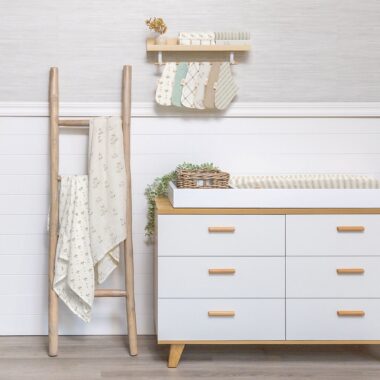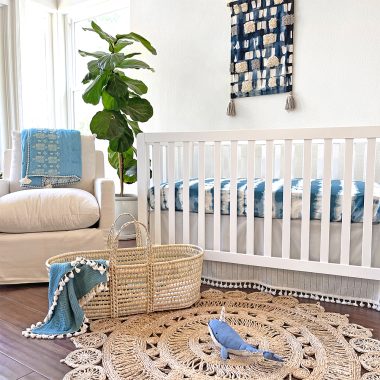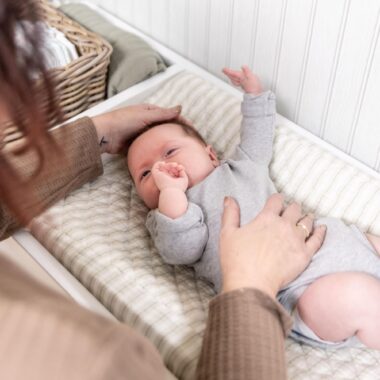Building, decorating, and organizing your nursery can be exhilarating. There’s a certain point in pregnancy when the “nesting” phenomenon hits, and your sole focus will be on the nursery.As you buy items and receive gifts from baby showers, you might be left with a huge pile of stuff. While it’s a great start, it is crucial to have everything organized and easy to access. Once baby arrives, you’ll be very sleep-deprived, and having things easily accessible will help you more than you know. It’s also important to be organized to keep baby safe and healthy too.
In this comprehensive guide to nursery organization, we’ll walk you through practical tips and creative ideas to make the process of setting up and maintaining your nursery a breeze. Whether you’re a first-time parent or looking to revamp your nursery space, our insights on nursery organization will ensure that you create a functional and aesthetically pleasing environment for both you and your baby. Here are a few baby nursery essentials and ideas to help you set up and organize your nursery!
Organizing a Baby Dresser
When it comes to organizing a baby dresser, selecting the right piece of furniture is the initial step in creating an efficient and aesthetically pleasing nursery. Size and space considerations are crucial factors to contemplate, ensuring that the chosen dresser fits seamlessly into the available space without overcrowding the room. Safety features are equally important, with a focus on anti-tip mechanisms to ensure the dresser’s stability in a nursery environment.

Once the ideal dresser is chosen, the next step involves categorizing baby clothes for optimal organization. Sorting clothes by size and age allows for easy access to the appropriate attire as your baby grows. Additionally, implementing a system for seasonal organization ensures that weather-appropriate clothing is readily available. This not only streamlines the dressing process but also makes it easier to keep track of clothing that may need replacing or updating.
Efficient folding techniques play a significant role in maximizing the limited space within a baby dresser. By adopting space-saving folding methods, such as the KonMari method or other compact folding techniques, parents can make the most of each drawer. Easy access tips further enhance the functionality of the dresser, making it simpler to locate specific items without disrupting the overall organization. Finally, the use of drawer dividers aids in sorting small items, such as socks, accessories, or tiny garments, maintaining order within each compartment and preventing a chaotic jumble of baby essentials.
Closet Organization for Nursery

Closet organization in a nursery requires careful layout planning to optimize the limited space available. A key strategy is to utilize vertical space effectively. This can be done by installing additional shelving or a tiered hanging system, allowing for the storage of a greater number of items in the same footprint. Allocating a shelf and hanging space is also essential. Designate specific areas for hanging clothes, like dresses and coats, and use shelves for folded items, such as sweaters and pants. By clearly defining these spaces, you create a streamlined system that simplifies both putting away laundry and dressing your baby.
Seasonal clothing management is another important aspect of nursery closet organization. Rotating outfits according to the season not only saves space but also keeps the closet relevant to your current needs. Store out-of-season clothing in clearly labeled bins or vacuum-sealed bags to keep them clean and safe until they are needed again.
Additionally, as babies grow quickly, regularly sorting and storing outgrown clothes is necessary to prevent clutter. Finally, ensuring accessibility and safety in the nursery closet is paramount. Keep everyday essentials within easy reach and child-proof the closet to prevent accidents. This might include installing locks on sliding doors or securing loose shelves and bins. An organized and safe closet not only makes life easier for parents but also creates a secure environment for your child.
Storage Under the Crib

Under the crib storage organization is an ingenious way to utilize every inch of space in your nursery, especially when dealing with limited room dimensions. The area beneath the crib, often overlooked, offers prime real estate for stashing essential baby items. So, buying a crib with drawers underneath can be really helpful when it comes to linen storage. Storing things like sets of crib sheets, wearable baby blankets, and swaddle blankets under your crib can make it easier to grab the items as needed. By neatly tucking items away in the drawers under the crib, the room maintains a serene and uncluttered appearance, essential for creating a calming environment for both the baby and parents. This method of storage not only optimizes the available space but also ensures that the nursery remains tidy and well-organized. Consider adding a stylish crib skirt to not only seamlessly cover the storage space underneath the crib, but to also add a decorative touch to the room.
Diaper Changing Station

Setting up an efficient and functional changing station is a crucial aspect of nursery organization. The key lies in choosing the right location. Ideally, the changing station should be situated close to the crib and dresser for convenience during those frequent diaper changes. This proximity minimizes the need to move across the room with a baby in arms, thereby enhancing safety and efficiency. Accessibility is another important factor; the changing station should be easily reachable and in a comfortable position for the parent to stand or sit during diaper changes. This thoughtful placement not only streamlines the process but also reduces the physical strain on the parent.
At the heart of a well-equipped changing station are the essentials: diapers, wipes, and creams. These items should be well-stocked and organized for quick access. A comfortable changing pad with washable changing pad covers ensures a soft, clean space for the baby during changes. Organizing changing supplies can be efficiently managed with the use of shelving and baskets, keeping everything from extra diapers to creams within arm’s reach.
Be Prepared
Speaking of changing stations, it’s important to be prepared with extra supplies. Always have an extra box of diapers and wipes on hand. That way, you always have a box, “on deck.” Once you open the spare box, take a minute to order a new box or put it on your shopping list. There is nothing worse than trying to find a diaper when you don’t have a new one on hand.
While you’re at it, consider keeping a few pairs of PJs and socks a size up, an extra can of formula, baby shampoo, baby detergent, etc., on hand. That way, if you’re in a pinch, you’ll have a little more time to get supplies.
Keep It Clean

As you’re putting together your nursery, you’ll start to notice that you have a lot of little items that don’t necessarily have a place with bigger items like diapers or sheets. So, organize smaller items with baskets and bins. Get soft baskets to keep blankets and stuffed animals in. If the nursery storage baskets are soft and light, your baby might even be able to incorporate them into imaginative play!
Don’t forget to pick up small organizing boxes for drawers. Having defined spaces for smaller items like socks, hats, pacifiers and more helps you keep drawers organized so you can find things much more quickly. In addition, make sure you dust, sanitize, and vacuum your baby’s room frequently. Having the room organized is great, but cleanliness is also important to keeping baby healthy and happy!
A Bin on Deck
Babies grow out of clothes very quickly. So, keep a large plastic bin (out of the reach of your kids) where you can put clothing they have grown out of. It’s no fun when you go to your baby’s closet only to realize that they have outgrown the vast majority of items hanging there. If you clean as you go, it’ll make it easier to know how many clothing items baby has and how much you need to buy. Once the bin is full, pull out 2-5 special outfits or items from each size to keep for the future. Donate unneeded items and use the bin to store what you want to keep for future babies. Don’t forget to label the bin with the size range!
Helpful Tools

There are a few other things that aren’t necessary, but can be really helpful for your nursery. Consider purchasing a humidifier and a NoseFrida for when baby gets their first cold. Make sure these are both stored out of reach, but having these on hand can help you during a late-night panic. Another thing that some moms swear by is wipe warmers. When baby wakes in the night and needs a quick change, there’s almost nothing that makes them more uncomfortable than cold wipes. So, getting a wipe warmer can make changes more peaceful and comfortable for the baby.
Another thing that people either love or hate is diaper pails. While they can help keep the smell of diapers from permeating your house, they can be bulky and expensive. If you don’t want to get a diaper pail, consider getting some diaper discard bags to keep at your changing station and in your diaper bag. They keep the stinky smells and leaks contained so you can put them in any trash bin without much fuss.
No matter which nursery storage ideas you follow, as long as the baby is safe and well taken care of, that’s what’s most important. While it can be nice to have all the latest gadgets, just do what you can, and add on to your nursery as you see the need.